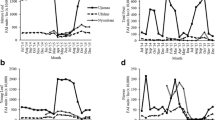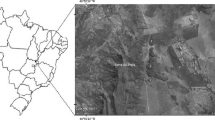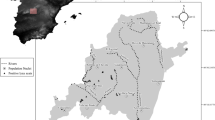Abstract
Basic information on culpeos’ ecology for vast regions of its range is lacking. A model was built explaining the differential abundance of culpeos in the high Ecuadorian Andes. This model considered several environmental variables and is the first approach to evaluate the culpeo’s habitat requirements in Ecuador. Fixed 1-km transects were established along paths in the highest areas of Podocarpus National Park. Here, a culpeo abundance index (AI) was calculated monthly for each transect during a year. The AI was derived from the occurrence frequency of scats, and genetic analyses were performed to confirm scat identifications. Environmental variables (e.g., climate, vegetation cover, environmental richness, and diversity) were measured at two spatial scales (microhabitat and landscape). Predictors were grouped into orthogonal factors, and general linear models (GLM) were obtained by applying a selection method of models. The results show that the highest culpeo abundances were associated with well-preserved homogeneous areas that had high levels of rainfall and extreme temperatures, with these features being characteristic of pure “paramo” at the highest altitudes. In addition, a strong positive relationship was also found with the abundance of the mountain tapir. It is suggested that the subspecies of culpeo inhabiting this region could be particularly adapted to the ecological conditions of paramo areas. If so, habitat fragmentation and ongoing changes in land use, as well as climate change, could be potential threats for the culpeo both in the study area and the entire Ecuadorian high-Andean ecosystem.



Similar content being viewed by others
Data availability
The datasets generated during and/or analyzed during the current study are not publicly available because they still are being used for further analyses and manuscripts, but are available from the corresponding author on reasonable request.
References
Acosta H, Cavelier J, Londono S (1996) Aportes al conocimiento de la biología de la danta de montaña, Tapirus pinchaque, en los Andes Centrales de Colombia. Biotropica 28:258–266
Acosta-Jamett G, Simonetti J (2004) Habitat use by Oncifelis guigna and Pseudalopex culpaeus in a fragmented forest landscape in central Chile. Biodivers Conserv 13:1135–1151
Becking M, Vergara H, Cabrera O (2004) La diversidad florística y ecosistémica de los Páramos del Sur. Primera aproximación de la Sintaxonomía de los Páramos del Sur. In: Becking M (ed) Sistema microregional de conservación Podocarpus. Tejiendo (micro) corredores de conservación hacia la cogestión de una Reserva de Biósfera Cóndor-Podocarpus. Programa Podocarpus, Loja, pp 95–123
Begon M, Townsend C, Harper J (2006) Ecology: from individuals to ecosystems. Blackwell Publishing Ltd, Liverpool
Blaum N, Rossmanith E, Schwager M, Jeltsch F (2007) Responses of mammalian carnivores to land use in arid savanna rangelands. Basic Appl Ecol 8:552–564
Borcard D, Legendre P (1994) Environmental control and spatial structure in ecological communities: an example using Oribatid mites (Acari, Oribatei). Environ Ecol Stat 1:37–61
Borcard D, Legendre P (2002) All-scale spatial analysis of ecological data by means of principal coordinates of neighbour matrices. Ecol Model 153:51–68
Borcard D, Legendre P, Drapeau P (1992) Partialling out the spatial component of ecological variation. Ecology 73:1045–1055
Burnham K, Anderson D (2002) Model selection and multimodel inference: a practical information-theoretic approach. Springer-Verlag, New York
Burton N (2007) Landscape approaches to studying the effects of disturbance on water birds. Ibis 149:95–101
Campos C, Ojeda R (1997) Dispersal and germination of Prosopis flexuosa (Fabaceae) seeds by desert mammals in Argentina. J Arid Environ 35:707–714
Carrillo E, Wong G, Cuarón A (2000) Monitoring mammal populations in Costa Rican protected areas under different hunting restrictions. Conserv Biol 14:1580–1591
Cornejo FA, Jiménez MP (2001) Dieta del zorro andino Pseudalopex culpaeus (Canidae) en el matorral desértico del sur de Perú. Rev Ecol Latinoamericana 8:1–9
Cuesta F, Peralvo M, Van Manen F (2003) Andean bear habitat use in the Oyacachi River basin. Ecuador Ursus 14:198–209
Cuyckens G, Perovic P, Cristobal L (2015) How are wetlands and biological interactions related to carnivore distributions at high altitude? J Arid Environ 115:14–18
De Angelo C, Paviolo A, Di Bitetti M (2011) Differential impact of landscape transformation on pumas (Puma concolor) and jaguars (Panthera onca) in the upper Paraná Atlantic Forest. Divers Distrib 17:422–436
De Barba M, Adams JR, Goldberg CS, Stansbury CR, Arias D, Cisneros R, Waits LP (2014) Molecular species identification for multiple carnivores. Conserv Gen Res 6:821–824
Dormann CF, McPherson JM, Araujo MB et al (2007) Methods to account for spatial autocorrelation in the analysis of species distributional data: a review. Ecography 30:609–628
Downer CC (1996) The mountain tapir, endangered ‘flagship’ species of the high Andes. Oryx 30:45–58
Downer CC (2001) Observations on the diet and habitat of the mountain tapir (Tapirus pinchaque). J Zool 254:279–291
Ebensperger LA, Mella JE, Simonetti JA (1991) Trophic-niche relationships among Galictis cuja, Dusicyon culpaeus, and Tyto alba in central Chile. J Mammal 72:820–823
Garavito NT, Álvarez E, Caro S et al (2012) Evaluación del estado de conservación de los bosques montanos en los Andes tropicales. Ecosistemas 21:148–166
Garrote G, Pérez de Ayala R, Tellería JL (2014) A comparison of scat counts and camera-trapping as means of assessing Iberian lynx abundance. Eur J Wildl Res 60:885–889
Graham M (2003) Confronting multicollinearity in ecological multiple regression. Ecology 84:2809–2815
Guntiñas M, Lozano J, Cisneros R, Narváez C, Armijos J (2017) Feeding ecology of the Culpeo in southern Ecuador: wild ungulates being the main prey. Contrib Zool 86:169–180
Herzog SK, Martínez R, Jørgensen PM, Tiessen H (2012) Cambio climático y biodiversidad en los Andes tropicales. Inter-American institute for Global Change Research (IAI) and Scientific Committee on Problems of the Enviroment (SCOPE), pp 348
Hijmans R, Cameron S, Parra J, Jones P, Jarvis A (2005) Very high resolution interpolated climate surfaces for global land areas. Int J Climatol 25:1965–1978
INAMHI (2012) Anuario Meteorológico 2012, Nro 49. Instituto Nacional De Meteorología e Hidrología, Dirección de Gestión Meteorológica, Procesamiento y Edición (SIGIHM). http://www.inamhi.gob.ec. Accessed 3 September 2016
IPCC (2014) Synthesis report. Contribution of working groups I, II and III to the Fifth Assessment Report of the Intergovernmental Panel on Climate Change. IPCC, Geneva
Jiménez JE, Novaro AJ (2004) Culpeo (Pseudalopex culpaeus). In: Sillero-Zubiri C, Hoffmann M, Macdonald D (eds) Canids: foxes, wolves, jackals and dogs. Status survey and conservation action plan. Canid Specialist Group, Gland, Switzerland and Cambridge, pp 44–49
Jiménez JE, Yáñez JL, Tabilo EL, Jaksic FM (1996) Niche-complementarity of South American foxes: reanalysis and test of a hypothesis. Rev Chil Hist Nat 69:113–123
Johnson WE, Franklin WL (1994) Role of body size in the diets of sympatric gray and culpeo foxes. J Mammal 75:163–174
Josse C, Cuesta G, Navarro V, Barrena E, Cabrera E, Chacón-Moreno W, Ferreira M, Peralvo J, Saito AT (2009) Ecosistemas de los Andes del norte y centro. Bolivia, Colombia, Ecuador, Perú y Venezuela. Secretaría General de la Comunidad Andina, Lima
Lantschner MV, Rusch V, Hayes JP (2012) Habitat use by carnivores at different spatial scales in a plantation forest landscape in Patagonia, Argentina. For Ecol Manag 269:271–278
Laundré JW, Hernández L, Altendorf KB (2001) Wolves, elk, and bison: reestablishing the “landscape of fear” in Yellowstone National Park, U.S.A. Can J Zool 79:1401–1409
Legendre P (1990) Evolutionary biogeography of the marine algae of the North Atlantic. NATO ASI Series. Springer-Verlag, Berlin
Lizcano DJ, Amanzo J, Castellanos A, Tapia A, Lopez-Malaga CM (2016) Tapirus pinchaque. The IUCN Red List of Threatened Species. https://doi.org/10.2305/IUCN.UK.2016-1.RLTS.T21473A45173922.en. Accessed 2 December 2016
Logan KA, Sweanor LL (2001) Desert puma. Evolutionary ecology and conservation of an enduring carnivore. Island press, Washington D.C
Lozano J (2010) Habitat use by European wildcats (Felis silvestris) in central Spain: what is the relative importance of forest variables? Anim Biodivers Conserv 33:143–150
Lozano J, Malo AF (2013) Relationships between human activity and richness and abundance of some bird species in the Paraguay River (Pantanal, Brazil). Ardeola 60:99–112
Lozano J, Virgós E, Cabezas-Díaz S, Mangas JG (2007) Increase of large game species in Mediterranean areas: is the European wildcat (Felis silvestris) facing a new threat? Biol Conserv 138:321–329
Lozano J, Virgós E, Cabezas-Díaz S (2013) Monitoring European wildcat populations using scat surveys in central Spain: are population trends related to wild rabbit dynamics or to landscape features? Zool Stud 52:16
Lucherini M (2016) Lycalopex culpaeus. The IUCN red list of threatened species. https://doi.org/10.2305/IUCN.UK.2016-1.RLTS.T6929A85324366.en. Accessed 2 December 2016
MAE (2009) Parque Nacional Podocarpus. Ministerio del Ambiente de Ecuador http://wwwambientegobec/parque-nacional-podocarpus Accessed 4 April 2016
Mangas J, Lozano J, Cabezas-Díaz S, Virgós E (2008) The priority value of scrubland habitats for carnivore conservation in Mediterranean ecosystems. Biodivers Conserv 17:43–51
Marquet P, Contreras L, Torresmura J, Silva S, Jaksic F (1993) Food habits of Pseudalopex foxes in the Atacama Desert, pre-Andean ranges, and the high-Andean plateau of northernmost Chile. Mammalia 57:131–135
Martínez DR, Rau JR, Jaksić FM (1993) Respuesta numérica y selectividad dietaria de zorros (Pseudalopex spp.) ante una reducción de sus presas en el norte de Chile. Rev Chil Hist Nat 66:195–202
Meserve P, Shadrick E, Kelt D (1987) Diets and selectivity of two Chilean predators in the northern semi-arid zone. Rev Chil Hist Nat 60:93–99
Mladenoff D, Sickley T, Haight R, Wydeven A (1995) A regional landscape analysis and prediction of favourable gray wolf habitat in northern Great Lakes region. Conserv Biol 9:279–294
Moreira-Arce D, Vergara PM, Boutin S, Carrasco G, Briones R, Soto GE, Jiménez JE (2016) Mesocarnivores respond to fine-grain habitat structure in a mosaic landscape comprised by commercial forest plantations in southern Chile. For Ecol Manag 369:135–143
Naranjo-Piñera E (1995) Abundancia y uso de hábitat del tapir (Tapirus bairdii) en un bosque tropical húmedo de Costa Rica. Vida Silvestre Neotropical 4:20–31
Noguera-Urbano EA, Ramírez-Chaves HE, Torres-Martínez MM (2016) Análisis geográfico y conservación del zorro andino Lycalopex culpaeus (Mammalia, Canidae) en Colombia. Iheringia 106:e2016014
Novaro AJ, Funes MC, Walker RS (2000) Ecological extinction of native prey of a carnivore assemblage in Argentine Patagonia. Biol Conserv 92:25–33
Novaro AJ, Funes MC, Walker RS (2005) An empirical test of source–sink dynamics induced by hunting. J Appl Ecol 42:910–920
Ojasti J, Dallmeier F (2000) Manejo de Fauna Silvestre Neotropical. SI/MAB Series 5. Smithsonian Institution/MAB Biodiversity Program, Washington D.C
Ortega-Andrade HM, Prieto-Torres DA, Gómez-Lora I, Lizcano DJ (2015) Ecological and geographical analysis of the distribution of the mountain tapir (Tapirus pinchaque) in Ecuador: importance of protected areas in future scenarios of global warming. PLoS One 10:e0121137
Palacios R, Walker RS, Novaro AJ (2012) Differences in diet and trophic interactions of Patagonian carnivores between areas with mostly native or exotic prey. Mamm Biol 77:183–189
Pia MV (2013) Trophic interactions between puma and endemic culpeo fox after livestock removal in the high mountains of Central Argentina. Mammalia 77:273–283
Pia MV, López MS, Novaro AJ (2003) Efectos del ganado sobre la ecología trófica del zorro culpeo (Pseudalopex culpaeus smithersi) (Carnivora: Canidae) endémico del centro de Argentina. Rev Chil Hist Nat 76:313–321
Pia MV, Renison D, Mangeaud A, De Angelo C, Haro J (2013) Occurrence of top carnivores in relation to land protection status, human settlements and rock outcrops in the high mountains of central Argentina. J Arid Environ 91:31–37
Rangel TF, Diniz-Filho JAF, Bini LM (2010) SAM: a comprehensive application for spatial analysis in macroecology. Ecography 33:46–50
Recio MR, Arija CM, Cabezas-Díaz S, Virgós E (2015) Changes in Mediterranean mesocarnivore communities along urban and ex-urban gradients. Curr Zool 61:793–801
Richter M (2003) Using epiphytes and soil temperatures for eco-climatic interpretations in southern Ecuador. Erdkunde 57:161–181
Ripple WJ, Estes JA, Beschta RL, Wilmers CC, Ritchie EG, Hebblewhite M, Berger J, Elmhagen B, Letnic M, Nelson MP, Schmitz OJ, Smith DW, Wallach AD, Wirsing AJ (2014) Status and ecological effects of the world’s largest carnivores. Science 343:1241484
Rivera J (2007) Parque Nacional Podocarpus. In: ECOLAP MAE. Guía del Patrimonio de Áreas Naturales Protegidas del Ecuador. ECOFUND, FAN, DarwinNet, IGM, Quito, pp 185–195
Romo MC (1995) Food habits of the Andean fox (Pseudalopex culpaeus) and notes on the moutain cat (Felis colocolo) and puma (Felis concolor) in the Rio Abiseo National Park. Peru Mammalia 59:335–344
Salvatori V, Vaglio-Laurin G, Meserve P, Boitani L, Campanella A (1999) Spatial organization, activity, and social interactions of culpeo foxes (Pseudalopex culpaeus) in north-central Chile. J Mammal 80:980–985
Sierra M (1999) Propuesta preliminar de un sistema de clasificación de vegetación para el Ecuador continental. Proyecto Inefan/Gef-Birf y Ecociencia, Quito
Simonetti JA, Grez AA, Estades CF (2013) Providing habitat for native mammals through understory enhancement in forestry plantations. Conserv Biol 27:1117–1121
Skole D, Tucker C (1993) Tropical deforestation and habitat fragmentation in the Amazon: satellite data from 1978 to 1988. Science 260:1905–1910
StatSoft Inc (2011) STATISTICA (data analysis software system), version 10. https://www.statsoft.com
Tirira D (2007) Guía de Campo de los Mamíferos del Ecuador. Murciélago Blanco, Quito
Tirira D (2011) Libro Rojo de los mamíferos del Ecuador. Fundación Mamíferos y Conservación, Pontificia Universidad Católica del Ecuador y Ministerio del Ambiente del Ecuador, Quito
Tuyttens FAM, Long B, Fawcett T, Skinner A, Brown JA, Cheeseman CL, Roddam AW, Macdonald DW (2001) Estimating group size and population density of Eurasian badgers Meles meles by quantifying latrine use. J Appl Ecol 38:1114–1121
Underwood AJ (1996) Experiments in ecology. Cambridge University Press, Cambridge
Webbon CC, Baker PJ, Harris S (2004) Faecal density counts for monitoring changes in red fox numbers in rural Britain. J Appl Ecol 41:768–779
Wilson DE, Mittermeier RA (2009) Handbook of the mammals of the world, carnivores. Lynx Edicions, Barcelona
Wilson DE, Reeder DM (2005) Mammal species of the world: a taxonomic and geographic reference. JHU Press, Baltimore
Zar JH (2009) Biostatistical analysis. Prentice Hall, Englewood Cliffs
Acknowledgements
The authors thank Santiago Burneo and María Alejandra Camacho of the Museum of Zoology at the Pontifical Catholic University of Ecuador (QCAZ), for their help and contribution to the study of the culpeo’s ecology in southern Ecuador, as well as Marco Salazar, César Cartuche, David del Pozo, Diego Ochoa, and Jorge Armijos for their crucial help during the field surveys. We express our gratitude to the Regional Ministry of Environment No. 7 in Loja for facilitating the research permits and to the rangers for helping us with the logistics and fieldwork. Lisette Waits (University of Idaho, USA) also helped us with performing the genetic analyses. Two anonymous referees improved the original manuscript with their comments.
Funding
This research was carried out with the economic support of the Universidad Técnica Particular de Loja (UTPL), Ecuador. Jorge Lozano was supported by a Prometeo Fellowship from SENESCYT, the National Agency for Education, and Science of the Government of Ecuador. He was also supported by Leuphana University of Lüneburg (Germany) and Complutense University of Madrid (Spain) during the editing of this paper.
Author information
Authors and Affiliations
Corresponding author
Ethics declarations
Conflict of interest
The authors declare that they have no conflict of interest.
Additional information
Publisher’s note
Springer Nature remains neutral with regard to jurisdictional claims in published maps and institutional affiliations.
Rights and permissions
About this article
Cite this article
Guntiñas, M., Lozano, J., Cisneros, R. et al. Habitat requirements and differential abundance of the culpeo (Lycalopex culpaeus) in the high Andes of southern Ecuador. Eur J Wildl Res 65, 18 (2019). https://doi.org/10.1007/s10344-019-1255-9
Received:
Revised:
Accepted:
Published:
DOI: https://doi.org/10.1007/s10344-019-1255-9




